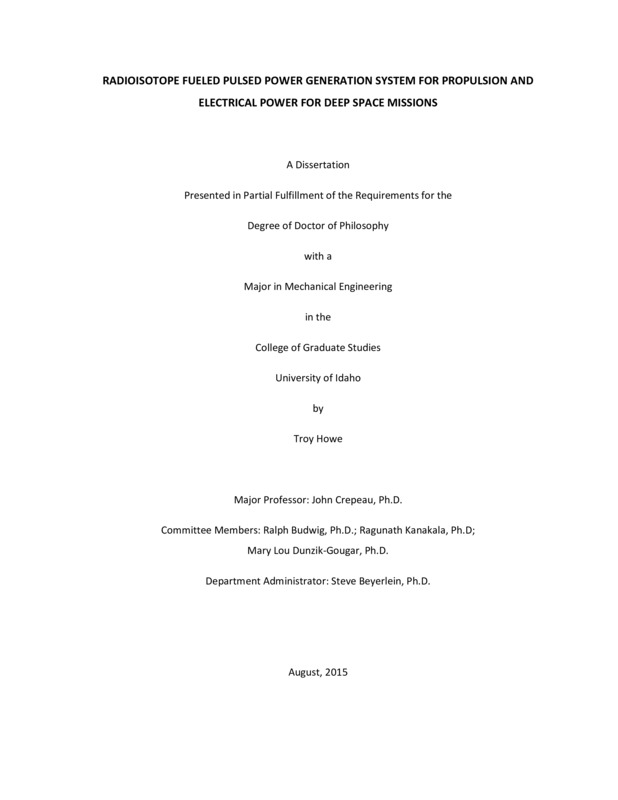RADIOISOTOPE FUELED PULSED POWER GENERATION SYSTEM FOR PROPULSION AND ELECTRICAL POWER FOR DEEP SPACE MISSIONS
Howe, Troy. (2015). RADIOISOTOPE FUELED PULSED POWER GENERATION SYSTEM FOR PROPULSION AND ELECTRICAL POWER FOR DEEP SPACE MISSIONS. Theses and Dissertations Collection, University of Idaho Library Digital Collections. https://www.lib.uidaho.edu/digital/etd/items/howe_idaho_0089e_10581.html
- Title:
- RADIOISOTOPE FUELED PULSED POWER GENERATION SYSTEM FOR PROPULSION AND ELECTRICAL POWER FOR DEEP SPACE MISSIONS
- Author:
- Howe, Troy
- Date:
- 2015
- Keywords:
- Cubesat Inexpensive Low-cost Molten Salt Radioisotope
- Program:
- Mechanical Engineering
- Subject Category:
- Mechanical engineering; Nuclear engineering; Aerospace engineering
- Abstract:
-
Space exploration missions to the moon, Mars, and other celestial bodies have allowed for great scientific leaps to enhance our knowledge of the universe; yet the astronomical cost of these missions limits their utility to only a few select agencies. Reducing the cost of exploratory space travel will give rise to a new era of exploration, where private investors, universities, and world governments can send satellites to far off planets and gather important data. By using radioisotope power sources and thermal storage devices, a duty cycle can be introduced to extract large amounts of energy in short amounts of time, allowing for efficient space travel. The same device can also provide electrical power for subsystems such as communications, drills, lasers, or other components that can provide valuable scientific information.
This project examines the use of multiple radioisotope sources combined with a thermal capacitor using Phase Change Materials (PCMs) which can collect energy over a period of time. The result of this design culminates in a variety of possible spacecraft with their own varying costs, transit times, and objectives. Among the most promising are missions to Mars which cost less than $17M, missions that can provide power to satellite constellations for decades, or missions that can deliver large, Opportunity-sized (185kg) payloads to mars for less than $53M. All made available to a much wider range of customer with commercially available satellite launches from earth. The true cost of such progress though lies in the sometimes substantial increase in transit times for these missions.
- Description:
- doctoral, Ph.D., Mechanical Engineering -- University of Idaho - College of Graduate Studies, 2015
- Major Professor:
- Crepeau, John
- Committee:
- Kanakala, Raghunath; Dunzik-Gougar, Mary Lou; Budwig, Ralf
- Defense Date:
- 2015
- Identifier:
- Howe_idaho_0089E_10581
- Type:
- Text
- Format Original:
- Format:
- application/pdf
- Rights:
- In Copyright - Educational Use Permitted. For more information, please contact University of Idaho Library Special Collections and Archives Department at libspec@uidaho.edu.
- Standardized Rights:
- http://rightsstatements.org/vocab/InC-EDU/1.0/

